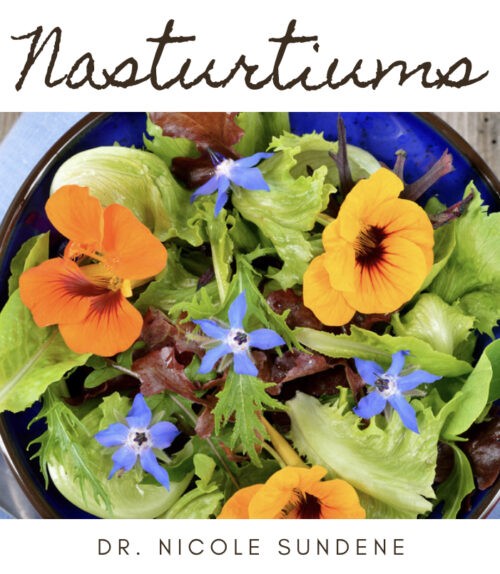
Dr. Nicole Sundene
"What is the best herb for my hormones to grow in my garden in Phoenix?" Amy
Nasturtium flowers are an edible, powerful, delicious "food as medicine" #1 favorite natural remedy for Women's Health and Hormones! Did you know the Nasturtium is actually part of the cabbage family and therefore has many similar magical powers along with a few of its own?
Scottsdale and Phoenix women should all know that these seeds grow easily on a drip line in Arizona, and are the perfect pretty garnish to meals and salads.
Today we will discuss the latest Nasturtium research I didn't even know about in the works such as potentially benefiting pulmonary fibrosis and lung damage!
I love to decorate my food with fresh edible flowers because it makes it indulgent and pretty without the calories. The best thing about nasturtiums is they grow easily on a drip line, need little maintenance, and look indulgent so your inner child will be happy eating less junk food and more pretty flowers!
Whenever I feel blah and tired I love to pick some fresh nasturtium flowers and leaves and eat them for an instant energy boost.
The rich orange pigment in the flowers and greens has a mild peppery flavor that pairs well with most salads and dinner dishes or serves as beautiful edible decor to make teas, drinks, and desserts fun and beautiful. Indulging in beautiful flowers is healthy and disease and inflammation reducing per my recent research we will discuss today.
Nasturtium is not only nutritious food but a rich source of glucosinolates which become the estrogen-lowering molecule sulforaphane once chewed. Eating as many plants as possible that reduce estrogen is important for women with estrogen-dominant conditions such as PMS, PCOS, Hashimoto's, Thyroid disease, and Perimenopause.
Herbalists have traditionally used Nasturtium officinale or “watercress” as we commonly know it to treat high blood pressure, diabetes, liver detox, and kidney disease.
The research studies below demonstrate that nasturtium is a cruciferous vegetable with potent antioxidant and anti-inflammatory benefits similar to the rest of the cabbage family. The phenylpropanoids are most concentrated in the flowers, second to the leaves, and least in the stems.
No wonder I always feel so amazing when I eat some fresh nasturtium flowers as their magical healing components are in a higher concentration in the flowers, although the leaves are delicious in salads and an easy green leafy veggie to grow!
The anti-inflammatory benefits of nasturtium are shown to be beneficial when applied topically and taken internally.
Nasturtium contains flavonoids, anthocyanins, glutathione, SOD (super oxide dismutase), and isoflavones that are also helpful for women against breast cancer, weight loss, chronic bladder problems, and anti-aging.
Scientists are currently studying how some of the properties of Nasturtium may have neuroprotective and anti-inflammatory properties that are specifically helpful to the nervous system and brain. The antioxidant properties in nasturtiums may be protective towards the liver and helpful against decreasing high LDL or “bad cholesterol” that causes heart disease as well as helpful for reducing post exercise induced inflammation in athletes.
Preliminary studies show the antioxidants in nasturtium improved collagen deposits in the lung condition pulmonary fibrosis, and while more studies are warranted to understand the mechanism and dosing it is generally a safe and harmless “food as medicine,” for patients with pulmonary fibrosis. Since many efficacious treatments are lacking for pulmonary fibrosis this warrants a full randomized control trial to determine dose, safety, and efficacy.
Patients that are physically disabled benefited from taking nasturtium in a research study and consumption resulted in fewer markers of inflammation including oxidative stress and c-reactive protein. Therefore nasturtium may also be beneficial for chronic pain via blocking COX pathways and demonstrates also antimicrobial properties against gram-positive bacteria in vitro. The isothiocyanates in nasturtium have been shown to be beneficial against UTI- Urinary Track Infections.
Nasturtium was found to be protective against gentamycin induced kidney damage and may have a future role in how we treat cancer patients undergoing chemotherapy.
While cancer patients and kidney patients deserve more research on nasturtium to understand the most efficacious dose, since nasturtium is essentially a food it should be fine to add more to the diet but as with any new herbal medicine always check with your Naturopathic Doctor!
If you need my help with your nutrition, hormones, women's health, or any of the aforementioned conditions simply pop over to my SCHEDULE page to treat yourself to a Naturopathic visit.
Dr. Nicole Sundene
(480) 837-0900
Dr. Sundene is a Naturopathic Doctor in Scottsdale, Arizona, and is a Female Hormone Expert in Women's Health and Bioidentical Hormones. She specializes in Holistic Women's Health for Menopause, Thyroid, Hashimotos, PMS, Perimenopause, Autoimmune, Postpartum, Chronic Fatigue, Depression, Anxiety, Food Allergies, Digestion, Dermatology, Acne, Psoriasis, Eczema, and Adrenal Hormonal Conditions. In 1999 she began working for a Hormone Doctor prior to starting Naturopathic Medical School. With over 23 years of experience in both Prescription and Natural women's health and hormones, she presents to women the best-integrated health solutions for their Chronic Disease.
She has been an Herbalist for over 28 years and enjoys teaching women how to use herbs to balance their hormones, nutrition and optimize their health. Dr. Sundene relies on blood testing for her hormone metrics. The hormone testing is covered per the patient's insurance plan (not Medicaid) and conducted at certain points in the woman's menstrual cycle. To learn more about Hormone Testing for Women Visit: Bioidentical Hormones. Follow Dr. Sundene on Instagram, Twitter, and Facebook for more tips on Women's Health, Female Hormones, and Naturopathy!
References:


